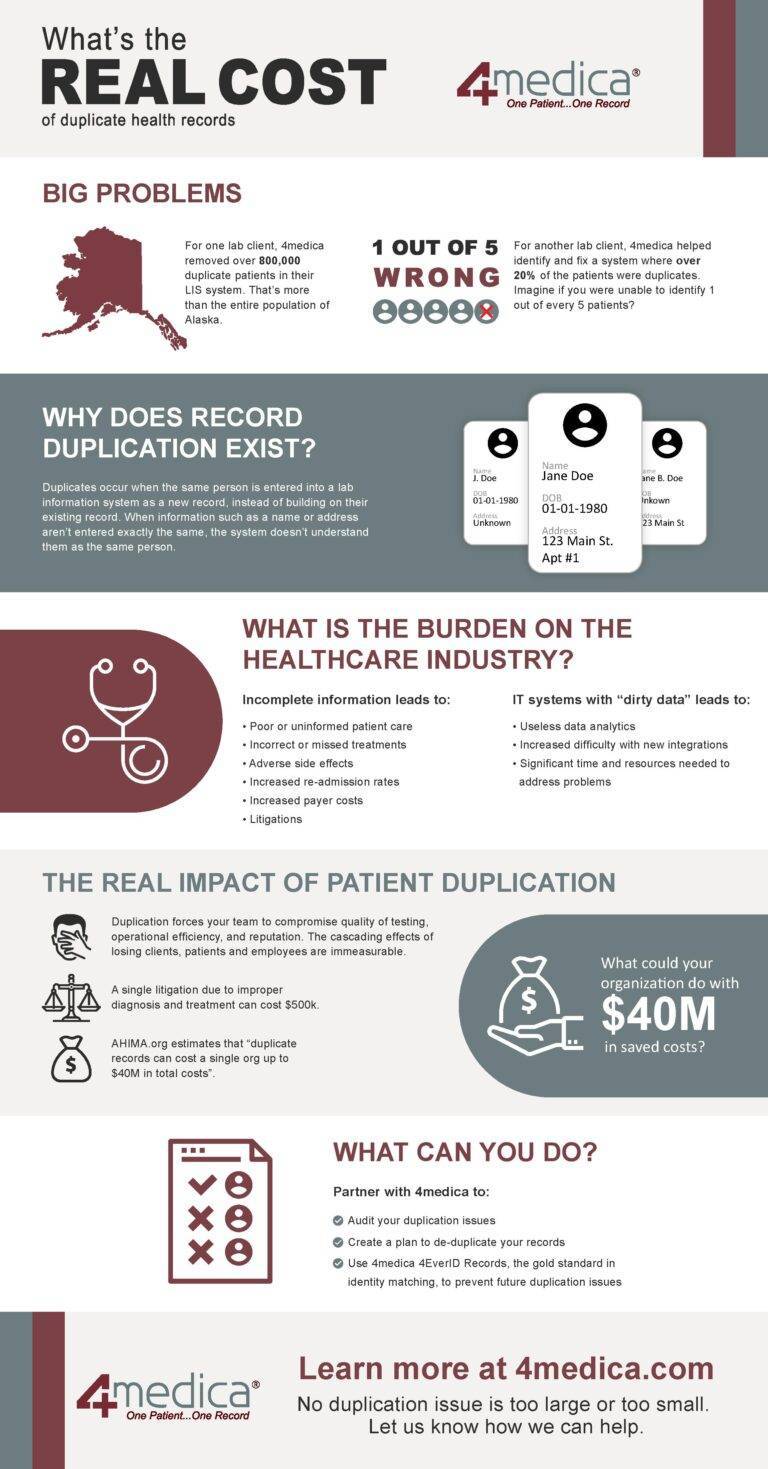What's the Real Cost of Duplicate Health Records?
Learn how duplicate health records can negatively impact patient care, healthcare operations, and your bottom line.
In today’s data-driven healthcare landscape, accurate and unified patient records are paramount. Unfortunately, a hidden enemy lurks within many healthcare systems: duplicate health records. These seemingly harmless duplicates can have a significant and far-reaching impact on patient care, operational efficiency, and, most importantly, your organization’s bottom line.
This infographic by 4medica sheds light on the true cost of duplicate health records. Did you know studies by AHIMA.org reveal a single organization can lose up to $40 million annually due to duplicate records? These duplicates arise from various sources, including:
- Data Entry Errors: Simple typos or inconsistencies in patient information during registration can create separate records.
- Mergers and Acquisitions: Combining data from different systems without proper reconciliation can lead to duplicates.
- Lack of Standardization: Variations in how patient names, addresses, or birthdates are recorded can trick systems into creating separate entries.
Consequences
The consequences of duplicate records are far-reaching and can negatively impact:
- Patient Care: Incomplete or inaccurate information in one record may be missed, leading to delayed diagnoses, incorrect treatment plans, or even medication errors.
- Operational Efficiency: Staff waste valuable time searching for and merging duplicate records, hindering productivity and workflow.
- Reimbursement Delays: Insurance companies may reject claims due to inconsistencies in patient information across records, delaying payments and disrupting cash flow.
- Increased Readmission Rates: Lack of complete medical history in a single record can result in unnecessary readmissions, driving up costs for both patients and healthcare organizations.
- Litigation Risks: Inaccurate patient information due to duplicates can increase the risk of lawsuits and legal fees.
Solutions
The infographic by 4medica doesn’t just highlight the problems; it offers solutions to achieve the ideal scenario: “One Patient… One Record.” Here are some key strategies:
- Data Cleansing and Standardization: Implementing data cleansing tools and consistent formatting protocols can help identify and eliminate existing duplicates.
- Master Patient Index (MPI): Utilizing an MPI system ensures a single, accurate record for each patient across all departments and facilities within your organization.
- Identity Matching and Verification: Leveraging advanced algorithms and verification processes can catch duplicates at the point of entry, preventing future problems.
4medica understands the challenges associated with duplicate health records. We offer a comprehensive suite of solutions, including:
- Data Quality Audits: Identify and assess the extent of duplicate records within your system.
- Data De-duplication Services: Our team helps you meticulously merge duplicates while maintaining data integrity.
- 4EverID Records Matching: This innovative technology ensures accurate patient identification and prevents the creation of duplicates in the future.
Impact
By addressing the issue of duplicate records, your healthcare organization can:
- Improve patient care by ensuring complete and accurate medical information is readily available.
- Streamline operations and boost staff productivity.
- Reduce costs by minimizing re-admissions, claim denials, and litigation risks.
- Enhance your organization’s reputation by prioritizing patient safety and data accuracy.
Don’t let duplicate records silently drain your resources and compromise patient care. Download the infographic by 4medica today and discover how we can help you achieve “One Patient… One Record.” Together, let’s create a more efficient and reliable healthcare system for all.

